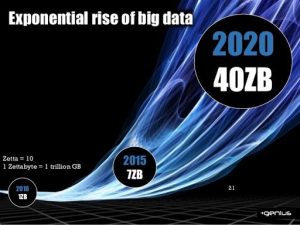Big Data consists of huge volumes of both structured and unstructured data, that is so large and difficult to process using traditional databases and software techniques. Big Data helps in understanding human behavior and uncertain business conditions through predictive analytics.

Big Data’s Leap
During the third century BC, Historians believed that the library of Alexandria was capable of holding all the data of human knowledge. But nowadays there is such an amount of data available in the world, to give each human 320 times as much of it could be stored in Alexandria’s entire library. If all of this information were placed on CDs and stacked up, it would form many pillars and reach to the moon twice.
This huge evolution of data is entirely new. Almost 90% of the total data in the world was realized recently.
In Earlier days only a quarter of all the world’s stored information was digital. Analog media, paper, and film preserve the rest of the data. But the amount of digital data is expanding at a rapid pace, that today less than two percent of data is not digital.
The purpose of Big Data is simply not new, it is everywhere. Big Data is growing and it is getting tougher and tougher for companies to understand. The effect of Big Data is everywhere, from business to science, from the government to the arts, where we are, what we like, what we buy and when we buy, with whom we interact and more. This clearly shows the rise of Big Data and how it is capturing the market.
The Publicity behind Big Data
It is not just about digitizing existing information. It’s about contributing more to our lives in data in real-time. So the experts recognized the need to re-think a new approach toward Big Data.
The Data needs to be made available in an understandable form for the right application context and the right portion size so that it can be turned into knowledge and eventually wisdom.
Data Scientists and Data Analysts need to know about data that can’t be ignored, data that they are not aware of and that can be fully utilized for analysis. In the foreground, it is the extension of human mental capabilities and data understandability.
Most of the social media platforms such as LinkedIn, Twitter, Facebook, Snapchat, and Instagram are examples of the real-time datafication of customer’s lives.
Now we hope you have an idea about the importance of Big Data in various sectors.
Big Data can be an advantage to the businesses but it is produced there has been some drawbacks and some people think about the Big Data in the same manner.
So, after having a tour about the reasons for the rise of Big Data, let’s move on to the drawbacks of Big Data.
The Drawbacks of Big Data
At present most of the companies are infusing the power of Big Data for their growth, strategic planning, decision making, and get an accurate and deep understanding of customer behavior. Nevertheless, many people believe that Big Data cannot offer what they want.
Though Big Data is having capabilities of answering questions about demand, desires, and behavior companies feel that it alone can’t provide them with what they want.
Because of these reasons, Big Data still needs to work for gaining some more confidence in people:
Difficulties for strategic decision making
All the companies need to learn how to manage information, analyze it in ways that advance their understanding of their customers, and then act intelligently in response to new understanding.
The companies first need to learn how to use the data already submerged in their core operating systems, just like people must master arithmetic before they tackle algebra. One of the important reasons that companies are unable to benefit fully from big data is that their management practices haven’t merged with their technology platforms.
For example, most of the companies that have installed digital platforms, such as Enterprise Resource Planning (ERP) systems and Customer Relationship Management (CRM) systems over the past years, yet they haven’t taken full advantage of the information they make available. Hence, there’s a need for cultural change in the companies so that they can have improved performance.
1. Big Data does not provide a complete picture
Apart from the fact that Big Data provides us with large information about every event of the customer, it does not give us the whole picture.
Big Data mostly provides information through social media from which most of the information is about young people. Even though many people are quite and could not pass any data because companies can’t hear them. Huge data alone can’t give us information as it may not necessarily mean more understandable as it does not necessarily reflect real life. The Public who spend a lot of time online is younger, better educated, and more prosperous than the overall population, offering many companies a limited view of existing and potential customers.
2. Big Data lacks the ‘why’
Big data can expose much about what’s going on, when it happens and where it happens. But we haven’t arrived at the day when Big Data can tell us ‘why’ customers behave in a certain way.
Big Data can take us far indeed, but still, at some point, human interaction and perspective are required to attain a decision. To understand the fluxes in customer behavior the ‘why’ behind changing behavior is needed to understand to get true comprehensions into customer behavior.
Summary
Big Data may not have all the answers for the companies to understand their customers but it holds enormous data to at least attain most of the valuable decisions of the economy.
After you approach this far you are now aware of the rise of the big data and the reasons behind the propaganda of Big Data.
So is Big Data all propaganda? Probably not. It is the future.
